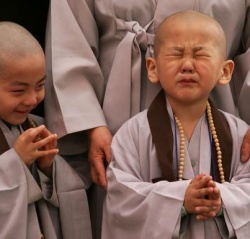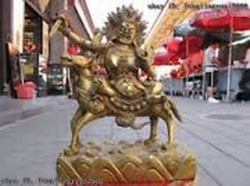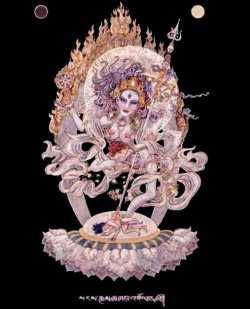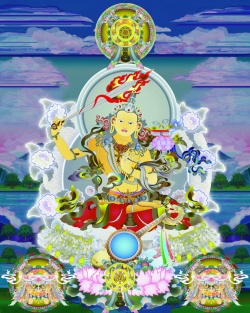Pure Land Buddhism in India and China
Pure Land Buddhists in East Asia often point to the great Indian Mahayana patriarchs Nagarjuna (c. 150-250) and Vasubandhu (c. 320-400) as advocates for the practice of Pure Land Buddhism. Nagarjuna, the founder of the Madhyamika school of Indian Mahayana Buddhism,
is credited with writing the Commentary on the Ten Stage Sutra (a sutra which is actually a chapter in the Flower Garland Sutra) in which it is said that there is a difficult way of attaining enlightenment through self-cultivation and an easy way of attaining
enlightenment by thinking of and calling upon the names of the buddhas of the ten directions. Devotion to Amitabha Buddha is especially recommended. The practice of keeping in mind and visualizing Amitabha Buddha in this commentary is not based upon the aforementioned
Triple Pure Land Sutras but rather upon another early Mahayana sutra called the Pratyutpanna Samadhi Sutra (Sutra on the Meditation to Behold the Buddhas). As we shall see, the Pratyutpanna Sutra would come to have a great influence on Chinese Buddhist practice, but
would eventually lose it’s place to the Triple Pure Land Sutras within the Pure Land Buddhist tradition.
Vasubandhu, one of the founders of the Indian Yogacara school of Buddhism, is credited with writing the Hymns of Aspiration for Birth [in the Pure Land), which is also known as the Discourse on the Pure Land when its auto-commentary is included.
The Hymns of Aspiration for Birth is a commentary on the Sutra of the Buddha of Infinite Life and it emphasizes the visualization of Amitabha Buddha, the merit contained in his name, and the saving power of his 18th vow.
In China, the monk Hui-yuan (334-416) is regarded as the founder of the Pure Land tradition. According to the traditional account, in the year 402 he gathered together 123 fellow monks, hermits, and literati together on Mt. Lu and founded the
White Lotus Society. The White Lotus Society dedicated themselves to the practice of the Pratyutpanna Sutra, which was translated into Chinese in the 2nd century C.E. Their practice consisted of chanting the name of Amitabha Buddha and visualizing the buddha and his
Pure Land of the West. They also rigorously observed the precepts and their aim was to retire from the world and aspire to rebirth in the Pure Land. They did not try to spread this teaching among the masses and Hui-yuan’s group passed away along with its founders.
However, it was to serve as an inspiration for later Pure Land practitioners and other groups going by the name of the White Lotus or Lotus Society in later times.
The practice of devotion to Amitabha Buddha also became a part of the T’ien-t’ai school from its inception. The founder, Chih-i (538-597), made Pure Land Buddhism an integral part of his system of meditative practice. Chih-i’s major work, the
Great Concentration and Insight, describes four kinds of meditation practice: (1) constant sitting, (2) constant walking, (3) half-walking and half-sitting, and (4) neither walking nor sitting. The constant walking meditation practice was based upon the Pratyutpanna Sutra. It consisted of circumambulating a statue of Amitabha Buddha while chanting that Buddha’s name and visualizing him.
Pure Land Buddhism quickly became a major feature of just about all forms of Chinese Buddhism. After the persecution of Buddhism by the Emperor Wu in 845, only the Pure Land and Zen schools continued to flourish in China. The Zen school initially
held itself aloof from and even criticized Pure Land Buddhism, but in the end Pure Land Buddhism was even incorporated into the Zen school by Zen Masters such as Yung-ming (904-975) and Chu-hung (1535-1615).
The Pure Land Buddhism which survived the persecution of 845 and which attained mass appeal throughout East Asia was not, however, the Pure Land Buddhism of the Pratyutpanna Sutra championed by Hui-yuan or Chih-i. Rather, it was the form of Pure Land Buddhism inspired by the Triple Pure Land Sutras. This form of Pure Land Buddhism deemphasized the visualization of Amitabha Buddha and the Pure Land of the West, and put much greater emphasis on the 18th vow, called the Original Vow, and the chanting of the name
of Amitabha Buddha to the virtual exclusion of all other practices.
Three teachers of Chinese Pure Land Buddhism in particular should be noted because they provided the major source of inspiration for the Pure Land movement of Honen in Japan. These teachers are T’an-luan (476-542), Tao-ch’o (562-645), and Shan-
tao (613-681).
T’an-luan started out as a monk in the Four Treatise school of Chinese Madhyamika Buddhism. When stricken with a grave illness, however, he turned to Taoism in order to discover a way to prolong his life. He then met an Indian monk named
Bodhiruci who converted him to Pure Land Buddhism by presenting him with translations of the Sutra of Meditation on the Buddha of Infinite Life and the Discourse on the Pure Land attributed to Vasubandhu. T’an-luan subsequently wrote a very influential commentary on
Vasubandhu’s Discourse. In his commentary, T’an-luan emphasized the distinction between the easy way and the difficult way of attaining enlightenment discussed in the Commentary on the Ten Stage Sutra attributed to Nagarjuna, the chanting of the name of Amitabha Buddha as a way of eradicating karmic evil, the importance of the mind of faith, and reliance upon the Other-power of Amitabha Buddha as opposed to reliance upon our own limited self-power. These and other teachings of T’an-luan would become important elements in Pure Land Buddhism.
Tao-ch’o considered himself a disciple of T’an-luan even though the latter had passed away long before Tao-ch’o was even born. Tao-ch’o was originally a teacher of the Nirvana Sutra; but at age 48, inspired by T’an-luan’s teachings and the Sutra of Meditation on the Buddha of Infinite Life, he became a fervent practitioner and popularizer of Pure Land Buddhism. In particular he taught that the Latter Age of the Dharma had already begun (according to his calculations wherein the age of the True Dharma was
believed to have lasted only 500 years) so the difficult Path of Sages was no longer a viable practice for people who should turn instead to the easy Path of Rebirth in the Pure Land.
Shan-tao was the direct disciple of T’an-luan and came to enjoy even greater esteem than his master. He wrote the Commentary on the Sutra of Meditation on the Buddha of Infinite Life that would have an enormous impact on Pure Land Buddhism. Shan-
tao divided all Buddhist practice into those practices that were based upon the Triple Pure Land Sutras and all those that were not. He termed the former the correct, and the latter the miscellaneous practices. Shan-tao then selected the practice of chanting the name
of Amitabha Buddha as the practice that would assure rebirth in the Pure Land, and referred to four other devotional practices as auxiliary practices. Shan-tao also expounded the three kinds of faith discussed in the Meditation on the Buddha of Infinite Life Sutra as
essential for rebirth: sincere faith, deep faith, and the faith that aspires to rebirth in the Pure Land. Finally, Shan-tao provided a very graphic depiction of the way of Pure Land Buddhism in terms of his famous parable of the two rivers and the white path. All of
these ideas and images would appear prominently in the teachings of the Japanese Pure Land movement begun by Honen.
by Ryuei Michael McCormick. 2004.



